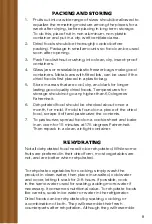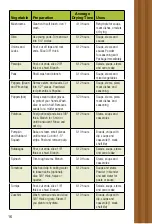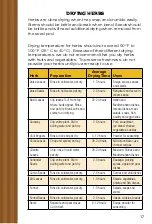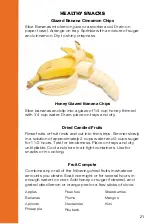
6
HOW TO SUCCEED AT DEHYDRATING
The fruits and vegetables you are about to use for
dehydration should be fresh and fully ripe. We recommend
organic produce whenever possible. Wilted, immature, or
over-ripe produce will make a dissatisfactory dried product.
To prepare your produce for dehydration, you should wash
all fresh food thoroughly to remove any dirt or chemicals.
Also make sure not to use any food with decay, bruises,
or mold, because it may affect the entire batch of food.
Don’t forget to peel, pit, or core some fruits and vegetables.
Smaller pieces tend to dry faster and more evenly.
Before dehydrating, remove excess liquid by patting the
ingredients dry. Avoid dripping any water or liquid onto the
electrical parts.
You should monitor the final stages of dehydration to ensure
the food is not over dried. Food should be dry enough to
prevent bacterial growth and spoilage. If the food is over
dried then it loses quality in taste, texture, and nutrition.
Before testing for dryness, take out a piece and let it cool
then feel for dryness.
1. Fruits should not have any spots of moisture, and should
be leathery. Another test is to tear the piece in half and
then watch for drops of moisture where you store it. If
there is no moisture then the fruit is read for storage.
2. Vegetables should be brittle.
3. Jerky should be tough.
go green
Preserve locally
grown produce and
bring homegrown,
delicious foods ba
ck
into your kitchen.
Summary of Contents for Turbo Food Dehydrator
Page 19: ...19 Fruit Recipes...
Page 25: ...25 Vegetable Recipes...
Page 31: ...31 Jerky Recipes...
Page 35: ...35 Arts and Crafts...







































